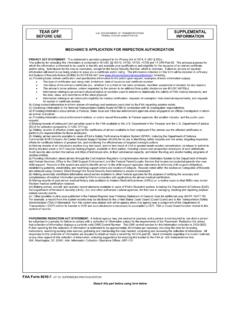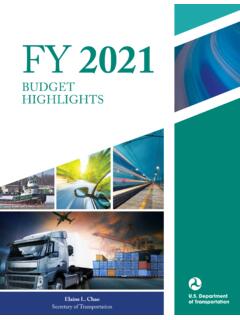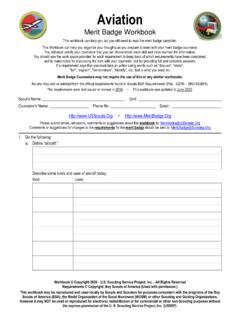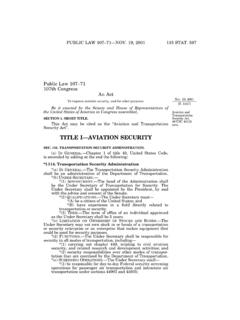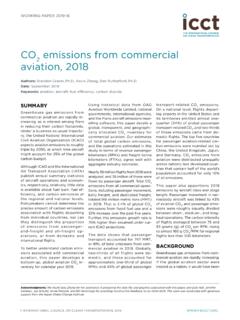Transcription of DEPARTMENT OF TRANSPORTATION Federal Aviation …
1 [4910-13-P] DEPARTMENT OF TRANSPORTATION Federal Aviation Administration 14 CFR Part 39 [Docket No. FAA-2021-0953; Project Identifier AD-2021-01169-T; Amendment 39-21810; AD 2021-23-12]RIN 2120-AA64 Airworthiness Directives; Transport and Commuter Category Airplanes AGENCY: Federal Aviation Administration (FAA), DOT. ACTION: Final rule; request for comments. SUMMARY: The FAA is adopting a new airworthiness directive (AD) for all transport and commuter category airplanes equipped with a radio (also known as radar) altimeter. This AD was prompted by a determination that radio altimeters cannot be relied upon to perform their intended function if they experience interference from wireless broadband operations in the GHz frequency band (5G C-Band). This AD requires revising the limitations section of the existing airplane/aircraft flight manual (AFM) to incorporate limitations prohibiting certain operations requiring radio altimeter data when in the presence of 5G C-Band interference as identified by Notices to Air Missions (NOTAMs).
2 The FAA is issuing this AD to address the unsafe condition on these products. DATES: This AD is effective [INSERT DATE OF PUBLICATION IN THE Federal REGISTER]. The FAA must receive comments on this AD by [INSERT DATE 45 DAYS AFTER DATE OF PUBLICATION IN THE Federal REGISTER]. This document was transmitted to the Federal Register on Dec. 7, 2021. Please refer to the Federal Register for the final, published version. 2 ADDRESSES: You may send comments, using the procedures found in 14 CFR and , by any of the following methods: Federal eRulemaking Portal: Go to Follow the instructions for submitting comments. Fax: 202-493-2251. Mail: DEPARTMENT of TRANSPORTATION , Docket Operations, M-30, West Building Ground Floor, Room W12-140, 1200 New Jersey Avenue SE, Washington, DC 20590. Hand Delivery: Deliver to Mail address above between 9 and 5 , Monday through Friday, except Federal holidays. Examining the AD Docket You may examine the AD docket at by searching for and locating Docket No.
3 FAA-2021-0953; or in person at Docket Operations between 9 and 5 , Monday through Friday, except Federal holidays. The AD docket contains this final rule, any comments received, and other information. The street address for the Docket Operations is listed above. FOR FURTHER INFORMATION CONTACT: Brett Portwood, Continued Operational Safety Technical Advisor, COS Program Management Section, Operational Safety Branch, FAA, 3960 Paramount Boulevard, Lakewood, CA 90712-4137; phone: 817-222-5390; email: This document was transmitted to the Federal Register on Dec. 7, 2021. Please refer to the Federal Register for the final, published version. 3 SUPPLEMENTARY INFORMATION: Background In March 2020, the United States Federal Communications Commission (FCC) adopted final rules authorizing flexible use of the GHz band for next generation services, including 5G and other advanced spectrum-based Pursuant to these rules, C-Band wireless broadband deployment is permitted to occur in phases with the opportunity for operations in the lower 100 megahertz of the band ( GHz) in 46 markets beginning as soon as December 5, 2021; however, the FAA does not expect actual deployment to commence until January 5, 2022.
4 This AD refers to 5G C-Band interference, but wireless broadband technologies, other than 5G, may use the same frequency These other uses of the same frequency band are within the scope of this AD since they would introduce the same risk of radio altimeter interference as 5G C-Band. In April 2020, RTCA formed a 5G Task Force, including members from RTCA, the FAA, aircraft and radio altimeter manufacturers, European Organisation for Civil Aviation Equipment (EUROCAE), industry organizations, and operators, to perform a quantitative evaluation of radar altimeter performance regarding RF interference from expected 5G emissions in the GHz band, as well as a detailed assessment of the risk of such interference occurring and impacting Aviation safety. 3 Based on the work of 1 The FCC s rules did not make C-Band wireless broadband available in Alaska, Hawaii, and the Territories.
5 2 The regulatory text of the AD uses the term 5G C-Band which, for purposes of this AD, has the same meaning as 5G , C-Band and GHz 3 RTCA Paper No. 274-20/PMC-2073, Assessment of C-Band Mobile Telecommunications Interference Impact on Low Range Radar Altimeter Options, dated October 7, 2020 (RTCA Paper No. 274-20/PMC-2073), page i. This document is available in Docket No. FAA-2021-0953, and at This document was transmitted to the Federal Register on Dec. 7, 2021. Please refer to the Federal Register for the final, published version. 4 the task force, RTCA published a report which concludes that there is a major risk that 5G telecommunications systems in the GHz band will cause harmful interference to radar altimeters on all types of civil aircraft including commercial transport airplanes; business, regional, and general Aviation airplanes; and both transport and general Aviation helicopters. 4 The report further concludes that the likelihood and severity of radio frequency interference increases for operations at lower altitudes.
6 That interference could cause the radio altimeter to either become inoperable or present misleading information, and/or also affect associated systems on civil aircraft. The RTCA report refers to FCC Report and Order (R&O) FCC 20-22,5 which identifies radio frequencies and power level conditions for the new C-Band services. The RTCA report identified the possibility of interference from both wireless emitters (on base stations, for example) as well as onboard user handsets. The RTCA report and conclusions remain under review, including by Federal spectrum regulators. The FAA risk assessment included consideration of the RTCA report, public comments to the RTCA report, and analyses from radio altimeter manufacturers and aircraft manufacturers in support of the safety risk determination. The analyses FAA considered were consistent with RTCA s conclusions pertaining to radio altimeter interference from C-Band emissions. The FAA determined that, at this time, no information has been presented that shows radio altimeters are not susceptible to interference caused by C-Band emissions permitted in the United States.
7 4 RTCA Paper No. 274-20/PMC-2073, page i. 5 FCC Report and Order (R&O) FCC 20-22 in the Matter of Expanding Flexible Use of the GHz Band, adopted February 28, 2020, and released March 3, 2020. This document is available in Docket No. FAA-2021-0953, and at This document was transmitted to the Federal Register on Dec. 7, 2021. Please refer to the Federal Register for the final, published version. 5 Additionally, the deployment of C-Band wireless broadband networks is occurring globally. In certain countries, deployment has already occurred in C-Band frequencies. In some countries, temporary technical, regulatory, and operational mitigations on C-Band systems have been implemented while Aviation authorities complete their safety assessments. Under the FCC rules adopted in 2020, base stations in rural areas of the United States are permitted to emit at higher levels in comparison to other countries which may affect radio altimeter equipment accuracy and reliability.
8 The radio altimeter is an important aircraft instrument, and its intended function is to provide direct height-above-terrain/water information to a variety of aircraft systems. Commercial Aviation radio altimeters operate in the GHz band, which is separated by 220 megahertz from the C-Band telecommunication systems in the GHz band. The radio altimeter is more precise than a barometric altimeter and for that reason is used where aircraft height over the ground needs to be precisely measured, such as autoland or other low altitude operations. The receiver on the radio altimeter is typically highly accurate, however it may deliver erroneous results in the presence of out-of-band radiofrequency emissions from other frequency bands. The radio altimeter must detect faint signals reflected off the ground to measure altitude, in a manner similar to radar. Out-of-band signals could significantly degrade radio altimeter functions during critical phases of flight, if the altimeter is unable to sufficiently reject those signals.
9 Many operators need to be able to land in low visibility conditions. These operators employ specially certified equipment and flightcrew training in order to be able to fly closer to the ground during approach in instrument conditions, in some cases all the way through the landing phase, without visual reference to the runway environment. This document was transmitted to the Federal Register on Dec. 7, 2021. Please refer to the Federal Register for the final, published version. 6 These operations can only be conducted with reference to actual height above the ground, as measured by a radio altimeter. Additionally, automatic and/or manual flight guidance systems on airplanes facilitate low visibility operations and rely on accurate radio altimeter inputs. These inputs determine when and where the aircraft flares for landing, when power reductions are made for landing, and when automated crosswind controls and other control inputs are made.
10 Anomalous (missing or erroneous) radio altimeter inputs to these systems may cause the aircraft to be maneuvered in an unexpected or hazardous manner during the final stages of approach and landing, and may not be detectable by the pilot in time to maintain continued safe flight and landing. Inaccurate radio altimeter data can result in pilots not trusting their instruments, eroding the foundation on which all instrument flight training is built. Although the FAA has determined the operations immediately at risk are those requiring a radio altimeter to land in low visibility conditions, a wide range of other automated safety systems rely on radio altimeter data. Harmful interference to the radio altimeter could cause these systems to operate in an unexpected way. The FAA continues to work with inter-agency and industry stakeholders to collect data on potential effects to these systems to determine whether additional mitigations are necessary.











